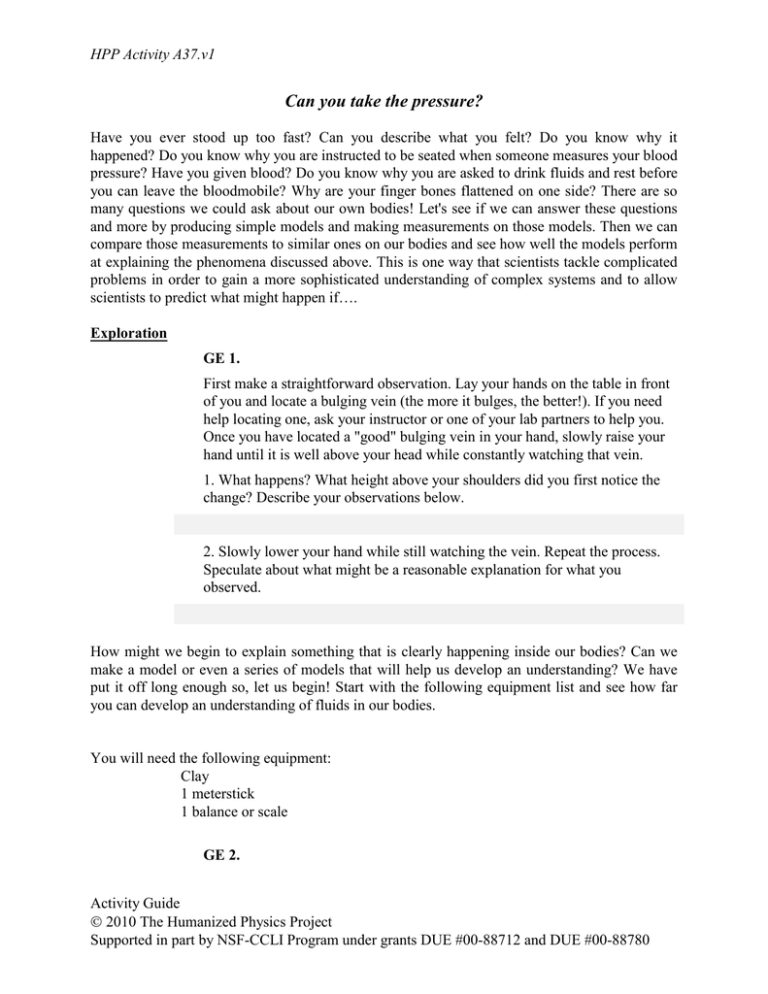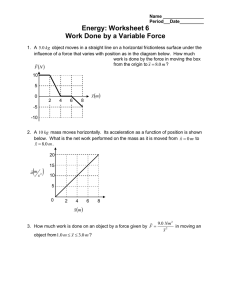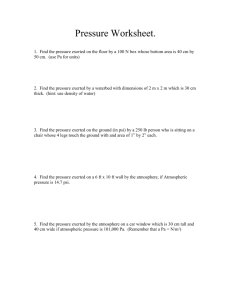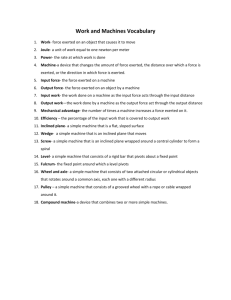Can you take the pressure?
advertisement

HPP Activity A37.v1 Can you take the pressure? Have you ever stood up too fast? Can you describe what you felt? Do you know why it happened? Do you know why you are instructed to be seated when someone measures your blood pressure? Have you given blood? Do you know why you are asked to drink fluids and rest before you can leave the bloodmobile? Why are your finger bones flattened on one side? There are so many questions we could ask about our own bodies! Let's see if we can answer these questions and more by producing simple models and making measurements on those models. Then we can compare those measurements to similar ones on our bodies and see how well the models perform at explaining the phenomena discussed above. This is one way that scientists tackle complicated problems in order to gain a more sophisticated understanding of complex systems and to allow scientists to predict what might happen if…. Exploration GE 1. First make a straightforward observation. Lay your hands on the table in front of you and locate a bulging vein (the more it bulges, the better!). If you need help locating one, ask your instructor or one of your lab partners to help you. Once you have located a "good" bulging vein in your hand, slowly raise your hand until it is well above your head while constantly watching that vein. 1. What happens? What height above your shoulders did you first notice the change? Describe your observations below. 2. Slowly lower your hand while still watching the vein. Repeat the process. Speculate about what might be a reasonable explanation for what you observed. How might we begin to explain something that is clearly happening inside our bodies? Can we make a model or even a series of models that will help us develop an understanding? We have put it off long enough so, let us begin! Start with the following equipment list and see how far you can develop an understanding of fluids in our bodies. You will need the following equipment: Clay 1 meterstick 1 balance or scale GE 2. Activity Guide 2010 The Humanized Physics Project Supported in part by NSF-CCLI Program under grants DUE #00-88712 and DUE #00-88780 HPP Activity A37.v1 2 Take a piece of clay. Form it into a block with one side about 15cm long and the other two sides about 1cm long. Stand the block on a table, as in the picture below. 1. Is a force exerted by the block on the table? If it is, determine the magnitude of the force exerted by the block on the table. Explain your reasoning. 2. Rotate the block, as in the picture below. Is a force exerted by the block on the table? If it is, determine the magnitude of the force exerted by the block on the table. Explain your reasoning. 3. Is the force exerted by the block on the table exerted at one point on the table? Or is it a force exerted by the block at different points along the table? Explain your reasoning. 4. Suppose you had a wedge of clay resting on a table, as in the diagram below. Would the force exerted by the clay on the table be the same at all points? Explain your reasoning. If not, where would the force be the least? Where would it be the greatest? 5. In the three cases above, would a force probe produce the same value if placed anywhere under the clay? You might imagine lots of tiny force probes spread out under the clay to answer this one. Activity Guide 2010 The Humanized Physics Project HPP Activity A37.v1 3 6. In each of the cases above, would you say that the force per unit area is constant? Explain. 7. Determine the force per unit area for the blocks in parts a. and b. above. Show your calculation. 8. In which case is the force per unit area greatest? Explain why you think so. Invention Pressure is defined as the force per unit area and this concept is used to help us characterize fluids. Mathematically, P = F/A The unit of pressure is a Pascal. One Pascal is one N/m2. The pressure exerted on us by the atmosphere is about 100,000 Pascals! Application GE3. Consider the two pictures below. In each case, the force applied is the same. In one case, the force is applied by a finger, in the other case, the part touching the skin is a needle.. (adapted from Physics with Health Science Applications by Paul Peter Urone, John Wiley and Sons, NY, 1986) 1. Which would hurt more? Explain Activity Guide 2010 The Humanized Physics Project HPP Activity A37.v1 2. In the 1950's women wore very sharp high heels and were barred from walking on wooden floors in some buildings. Explain why you think so. Activity Guide 2010 The Humanized Physics Project 4




